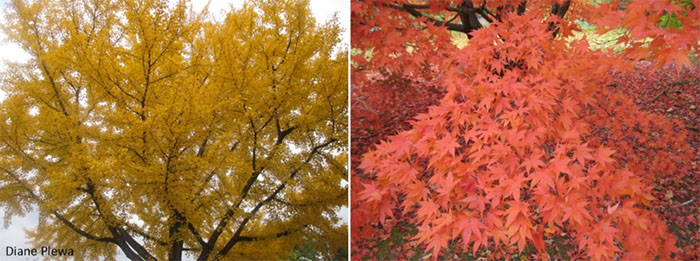Issue 17, September 28, 2015
Sanitation Information

Two common deciduous trees, a ginkgo and maple, turning colors in autumn. Once the leaves fall, they should be collected and removed from the landscape.
With the first day of fall last week, it's time to start thinking about the end of the season. While a good deal of time and effort goes into preparing a new seed bed or ammending soil prior to planting in spring, many people overlook the importance of garden work in autumn. It could be due to a lack of knowledge, gardening burn-out, or simply the fact that it's difficult to be motivated to do work that you won't see the benefit of for several months. However, fall sanitation is one of the most important steps for controlling a large number of diseases.
A wide variety of fungi overwinter in plant tissue. If the tissue is still part of the plant, (such as an insect larva or fungal spore snug within the trunk of a tree or the cane of a bramble), removing the pest involves finding it within the plant and removing that section of the plant. This can be time-consuming, difficult, and will cause some damage to the host. In comparison, many diseases that overwinter in plant debris are very easy to remove: simply remove the plant debris from the landscape, and you will control the majority of the initial pest population in spring. Although many insect pests overwinter in debris, they are not limited to the host tissue. Most insect pests, along with their predators, are as likely to overwinter in a fence row or at the base of shrubs as they are in host plant debris.
When we talk about sanitation, we usually recommend removing all plant debris. This will be more feasable in some situations than others, but fallen leaves from deciduous trees and annual plants that will die at frost are the most common. Plant material should be raked, then removed, composted, or burned (where allowed). A quick note about composting: a proper compost pile will reach high internal temperatures and degrade organic matter, including pests. Many compost piles are simply heaps of plant matter, which may or may not reach the internal temperatures required to kill pests. Still, degrading the plant material should help reduce some pest pressures, and will provide additional organic matter to add to beds and gardens.
One common plant product that is often overlooked when sanitizing a garden is pine cones. A fungal disease frequently seen on Illinois pine trees, Diplodia tip blight, produces fruiting bodies full of spores on both the needles and cones of infected trees. By removing the infected pine cones, you can greatly reduce the ammount of inoculm present in the environment next spring, when new tissue is infected.
Encouraging the degradation of plant material is another form of sanitation. Many fungi that overwinter in plant debris rely on the tissue to protect them from the harsh environment, and to feed them at the beginning of spring. By degrading that tissue, the fungi are more likely to be exposed to unfavorable environmental conditions or weakened by the time spring comes. If raking and removing leaves or herbacious stems is not feasable in large plantings, mowing and mulching the plant litter has been shown to reduce infection the following year for certain fungal diseases.
Sometimes plant debris is intentially left in the garden to serve as a proctive mulch for plants, or to feed wildlife (such as flowers that produce seedheads for birds). Normally leaving this organic matter in the garden is fine, but if the plants suffered a large infection in the summer I would recommend removing as much organic matter as possible that fall to reduce pest populations the following year. (Diane Plewa)
Author:
Diane Plewa